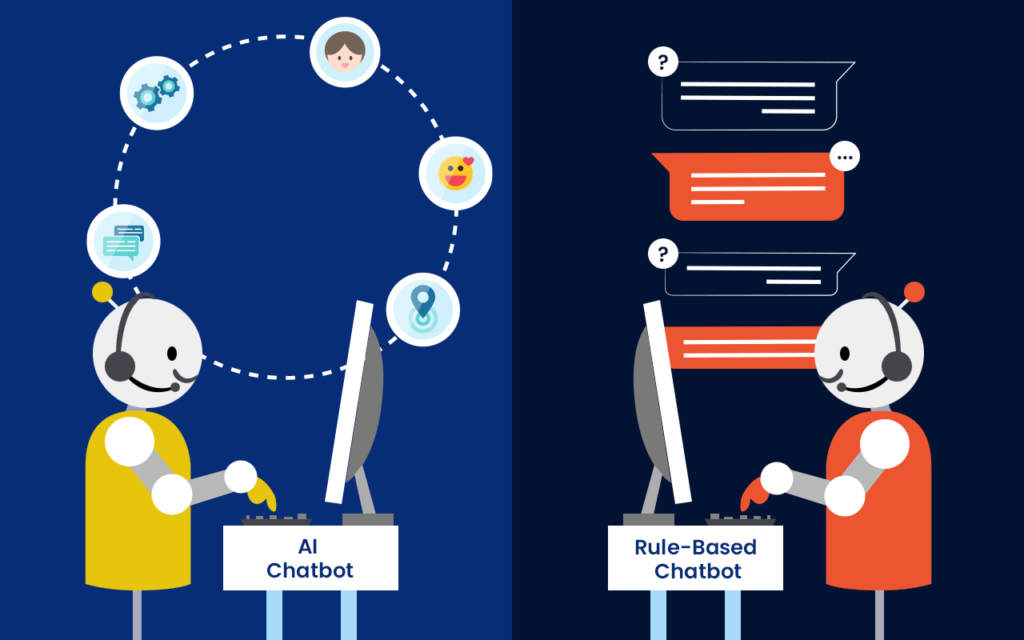
As businesses increasingly adopt chatbots for customer support and engagement, understanding the difference between AI chatbots and rule-based bots becomes crucial. While both serve to automate interactions, their functionality and potential are vastly different. In this article, we’ll explore these differences and highlight why AI chatbot training is essential for unlocking their full potential.
What Are AI Chatbots?
AI chatbots are powered by artificial intelligence and machine learning algorithms. These bots are capable of understanding context, processing natural language, and learning from user interactions to improve over time.
Key Features of AI Chatbots:
-
Natural Language Processing (NLP): Enables them to understand and respond in a human-like manner.
-
Contextual Understanding: Can maintain a conversation by remembering previous interactions.
-
Learning Capabilities: Improve their responses through continuous AI chatbot training.
-
Personalization: Adapt their communication style to suit individual users.
Use Cases for AI Chatbots:
-
Customer support with complex queries.
-
Personalized marketing campaigns.
-
Automating routine internal tasks, such as HR inquiries.
What Are Rule-Based Bots?
Rule-based bots, on the other hand, operate on a predefined set of rules and decision trees. These bots can only respond to specific commands or questions programmed into them.
Key Features of Rule-Based Bots:
-
Scripted Responses: Follow fixed workflows and cannot deviate from their programming.
-
Keyword-Driven: Trigger responses based on exact keywords or phrases.
-
Limited Scope: Perform well for straightforward, repetitive tasks but lack flexibility.
-
No Learning Capability: Require manual updates for any new functionality or changes.
Use Cases for Rule-Based Bots:
-
Answering frequently asked questions (FAQs).
-
Basic lead generation through forms.
-
Simplistic navigation assistance on websites.
Key Differences Between AI Chatbots and Rule-Based Bots
1. Flexibility and Scalability
-
AI Chatbots: Highly adaptable, making them suitable for dynamic and evolving requirements. Continuous AI chatbot training enhances their ability to handle diverse tasks.
-
Rule-Based Bots: Limited to predefined scenarios, requiring manual updates for any new functionality.
2. Complexity of Interaction
-
AI Chatbots: Handle complex queries and engage in multi-turn conversations by understanding user intent.
-
Rule-Based Bots: Struggle with complex queries and fail if users deviate from predefined scripts.
3. Learning and Improvement
-
AI Chatbots: Learn from interactions and improve over time, reducing the need for constant updates.
-
Rule-Based Bots: Static in nature, requiring frequent manual updates to stay relevant.
4. Development and Maintenance
-
AI Chatbots: Involve advanced processes like custom chatbot development to tailor solutions for specific needs.
-
Rule-Based Bots: Easier and quicker to develop but lack advanced capabilities.
Why AI Chatbot Training Matters
The effectiveness of an AI chatbot depends significantly on the quality and extent of its training. Unlike rule-based bots, AI chatbots require extensive data and iterative training to achieve optimal performance.
Key Benefits of Training AI Chatbots:
-
Enhanced Accuracy: Training ensures the chatbot accurately interprets user inputs, even if phrased differently.
-
Improved User Experience: By learning from previous interactions, AI chatbots can provide personalized and contextually relevant responses.
-
Scalability: With robust training, AI chatbots can handle a broader range of queries, reducing the need for human intervention.
-
Continuous Improvement: Ongoing AI chatbot training enables the bot to adapt to new trends, languages, and user behaviors.
The Role of Custom Chatbot Development
For businesses with unique requirements, custom chatbot development plays a pivotal role. A tailored AI chatbot can align perfectly with your brand’s objectives and customer expectations.
Advantages of Custom Chatbot Development:
-
Business-Specific Functionality: Incorporates features that cater to your industry’s specific needs.
-
Integration: Seamlessly integrates with existing systems such as CRMs, ERPs, or e-commerce platforms.
-
Brand Consistency: Reflects your brand’s tone, style, and values.
Which Solution Is Right for You?
Choose AI Chatbots If:
-
You require advanced conversational abilities.
-
Scalability and adaptability are critical for your operations.
-
You want to leverage machine learning for continuous improvement.
Choose Rule-Based Bots If:
-
Your needs are straightforward and predictable.
-
You require a quick and cost-effective solution.
-
You’re handling basic queries or guiding users through predefined workflows.
Conclusion
Understanding the differences between AI chatbots and rule-based bots is essential for choosing the right solution for your business. While rule-based bots are suitable for simple tasks, AI chatbots offer unparalleled flexibility, learning, and personalization. However, their success depends heavily on comprehensive AI chatbot training and, when necessary, custom chatbot development to address specific business needs.
Ready to explore the potential of AI chatbots? Start with proper training and development to unlock their full capabilities and transform your customer interactions today!





Leave a Reply